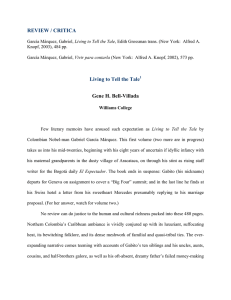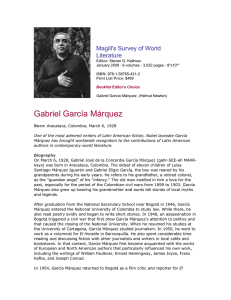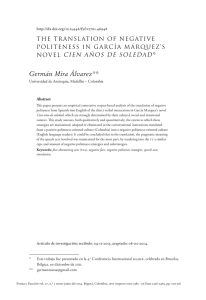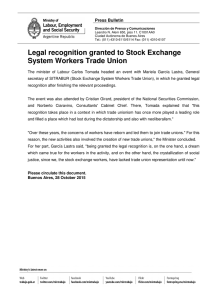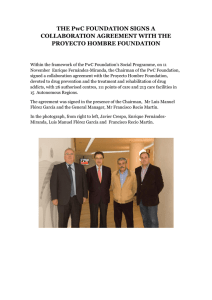English - SciELO Colombia
Anuncio
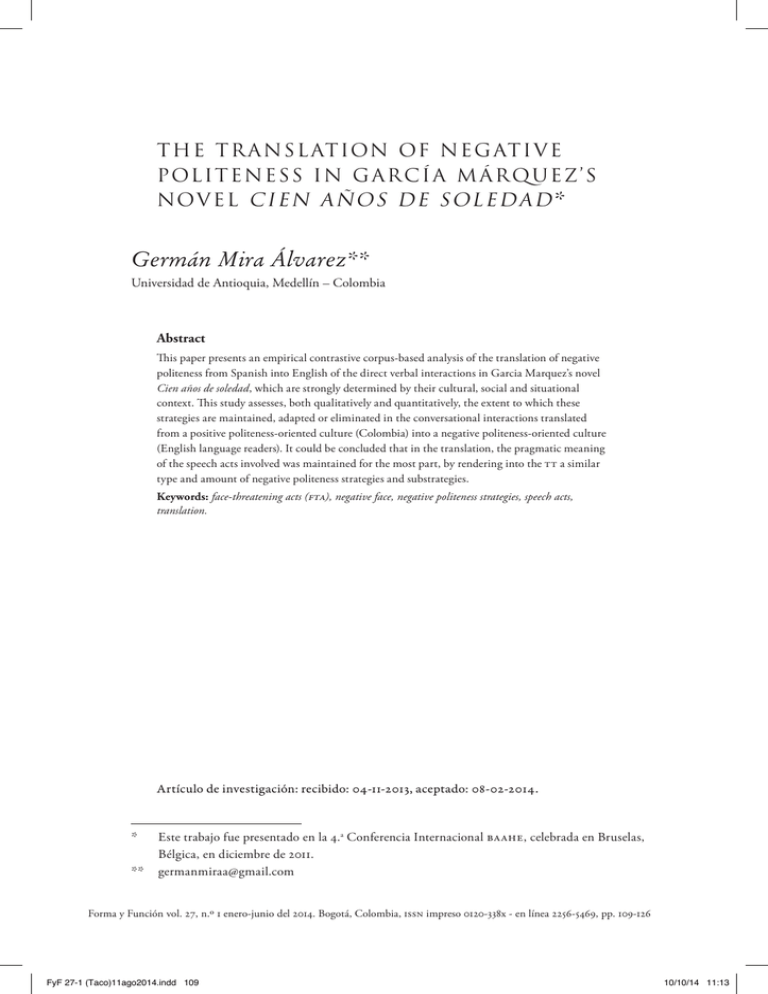
THE TR A NS L AT ION OF N E G AT IV E POL I T ENES S I N G AR C ÍA M ÁR Q UE Z ’S NOV EL CIEN AÑOS DE SOLEDAD * Germán Mira Álvarez** Universidad de Antioquia, Medellín – Colombia Abstract This paper presents an empirical contrastive corpus-based analysis of the translation of negative politeness from Spanish into English of the direct verbal interactions in Garcia Marquez’s novel Cien años de soledad, which are strongly determined by their cultural, social and situational context. This study assesses, both qualitatively and quantitatively, the extent to which these strategies are maintained, adapted or eliminated in the conversational interactions translated from a positive politeness-oriented culture (Colombia) into a negative politeness-oriented culture (English language readers). It could be concluded that in the translation, the pragmatic meaning of the speech acts involved was maintained for the most part, by rendering into the TT a similar type and amount of negative politeness strategies and substrategies. Keywords: face-threatening acts (FTA), negative face, negative politeness strategies, speech acts, translation. Artículo de investigación: recibido: 04-11-2013, aceptado: 08-02-2014. * Este trabajo fue presentado en la 4.a Conferencia Internacional BAAHE, celebrada en Bruselas, Bélgica, en diciembre de 2011. **[email protected] Forma y Función vol. 27, n.º 1 enero-junio del 2014. Bogotá, Colombia, issn impreso 0120-338x - en línea 2256-5469, pp. 109-126 FyF 27-1 (Taco)11ago2014.indd 109 10/10/14 11:13 110 Germán Mira Álvare z L A T R A DU CC IÓN DE L A CORT E SÍA NE G AT IVA E N L A NOV E L A CIEN AÑOS DE SOLEDAD DE G AR C ÍA M ÁR QU E Z Resumen Este artículo presenta un análisis empírico contrastivo de la traducción al inglés de la cortesía negativa en las interacciones verbales de la novela Cien años de soledad, de García Márquez, las cuales están fuertemente condicionadas por su contexto cultural, social y situacional. El propósito de este estudio es determinar, cualitativa y cuantitativamente, el grado en el que estas estrategias se mantienen, adaptan o se eliminan en la traducción de las interacciones conversacionales propias de una sociedad típicamente orientada a la cortesía positiva (Colombia), hacia una orientada a la cortesía negativa (lectores en lengua inglesa). Se pudo concluir que, en la traducción, el significado pragmático de los actos de habla se conservó, en la mayoría de los casos, trasladando al TM un tipo y una cantidad similar de estrategias y subestrategias de cortesía negativa. Palabras clave: actos amenazadores de la imagen, imagen negativa, estrategias de cortesía negativa, actos de habla, traducción. A T R A DU Ç Ã O DA CORT E SI A NE G AT IVA NO R OM ANC E Cien años de soledad DE G A R C ÍA M ÁR QU E Z Resumo Este artigo apresenta uma análise empírica contrastiva da tradução ao inglês da cortesia negativa nas interações verbais do romance Cien años de soledad, de García Márquez, as quais estão fortemente condicionadas por seu contexto cultural, social e situacional. O propósito deste estudo é determinar, qualitativa e quantitativamente, o grau no qual essas estratégias se mantêm, adaptam ou eliminam-se na tradução das interações conversacionais próprias de uma sociedade tipicamente orientada à cortesia positiva (Colômbia), a uma orientada à cortesia negativa (leitores em língua inglesa). Pôde-se concluir que, na tradução, o significado pragmático dos atos de fala foi conservado, na maioria dos casos, deslocando ao TT um tipo e uma quantidade similar de estratégias e subestratégias de cortesia negativa. Palavras-chave: atos ameaçadores da imagem, imagem negativa, estratégias de cortesia negativa, atos de fala, tradução. Universidad Nacional de Colombia, Facultad de Ciencias Humanas, Departamento de Lingüística FyF 27-1 (Taco)11ago2014.indd 110 10/10/14 11:13 T H E T RANS LAT IO N O F NE G AT I V E P OL I TE N E SS I N GA R C Í A M Á R QU E Z ’ S N OV E L . . . 111 Introduction The aim of this article is to assess the transfer of negative politeness in the translation from Spanish into English of the direct verbal interactions in García Marquez’s novel Cien Años de Soledad ([1967] 1985) and its English language version translated by Gregory Rabassa (1970), the only known translation of the novel into English to date. The level of politeness is assessed in terms of the kind and amount of negative politeness strategies and substrategies used by the speakers in the source text (ST) and how these are rendered in the translation (whether on record/off record strategies, and politeness substrategies such as indirection, hedging, deference, apology etc., are maintained, eliminated, added or adapted in the target text (TT)). Since the analysis presented here focuses exclusively on the translation of negative politeness, the conversational exchange samples making up the corpus of this study involve all the verbal interactions in which there is some kind of face-threatening act (FTA) (Brown & Levinson, 1987, p. 65), which constitutes a threat to the negative face of the hearer. As to the methodology used in this study, firstly, the individual speech acts were identified and extracted from the source novel in their context, that is to say, together with all continuous antecedent and subsequent text that does not belong to a new speech act. They were then analyzed and validated against the theoretical concepts related to politeness strategies, as developed by Brown and Levinson (1987). The degree of politeness of each speech act was then assessed, taking account of the type of politeness strategies and the number of substrategies identified in each one, and considering the dimensions of Power (P), Distance (D) and Imposition or culturally ranked intrinsic threat (R) posed by the FTA, also as proposed by Brown and Levinson (1987, p. 74). Subsequently, the corresponding pair was found and extracted from the translated text, and the same procedure as in the ST was followed to determine the degree of politeness of the speech act in the TT. The contrastive analysis has allowed us to conclude that in the translation, the pragmatic meaning of the speech acts involved was maintained for the most part, by rendering into the TT a similar type and amount of negative politeness strategies and substrategies. These findings will be discussed under the assumption that the source and the target cultures of the two texts are characterized by markedly different, if not opposite, manifestations of politeness (Hickey & Stewart, 2005). With this study we want to contribute to corpora-based cross-cultural research into politeness norms involving different language pairs, and at the same time, provide translators with criteria to make translation decisions when translating negative politeness. Forma y Función vol. 27, n.º 1 enero-junio del 2014. Bogotá, Colombia, issn impreso 0120-338x - en línea 2256-5469, pp. 109-126 FyF 27-1 (Taco)11ago2014.indd 111 10/10/14 11:13 112 Germán Mira Álvare z Politeness theory According to Brown and Levinson (1987), politeness refers to expressing things in such a way as to take account of the feelings of the hearer. These feelings can be of two kinds: those concerned with every person’s want to be appreciated and approved of by other people (positive face), and those concerned with every person’s want to be free from imposition and distraction and to have his or her own personal prerogatives and territory respected (negative face). Thus, the authors distinguish positive and negative politeness. The former consists of attending to other people’s desire that their self-image be appreciated and approved of, by expressing interest and respect for them. The latter, which is the focus of this study, consists of leaving people free to act and free from imposition, by being indirect when requesting them to do anything and by apologizing for any necessary intrusion. Some types of speech acts, as classified by Searle (1976), such as directives – including commands, requests and advice – constitute a threat to negative face since with them the speaker intrudes upon the free self-determination of the hearer (Brown & Levinson, 1987, p. 61). When performing those speech acts, speakers normally make use of any of a set of politeness strategies to minimize the harm to the hearer’s negative face. Brown and Levinson’s politeness theory (1987, p. 76) holds that the selection of such strategies is universally determined by three variables which condition the level of politeness expected in the interactions: the horizontal or social distance between the speaker and hearer (D), the vertical distance or power of the hearer over the speaker (P), and the degree of imposition or culturally ranked intrinsic threat posed by the FTA (R). The authors claim that the weightiness or riskiness of FTAs (W) is a function of the social distance between the speaker and the hearer, plus the power of the hearer over the speaker, plus the threat posed by the FTA. This means that the degree of politeness of an act should be greater when D is high, when the power of the hearer over the speaker is high, or when R is high. In this regard, three of the five politeness maxims proposed by Leech (1983, p. 123) express a similar relationship of those variables in the form of scales: cost/benefit scale, authority scale and social distance scale. These correspond to R, P and D variables in Brown and Levinson, respectively. The other two (i.e., the optionality scale and the indirectness scale) are respectively related to one of the redressive substrategies (give hearer an out) and the off-record strategies, which are part of the set of negative politeness strategies proposed by Brown and Levinson (1987, pp. 60-69) and presented below. Universidad Nacional de Colombia, Facultad de Ciencias Humanas, Departamento de Lingüística FyF 27-1 (Taco)11ago2014.indd 112 10/10/14 11:13 T H E T RANS LAT IO N O F NE G AT I V E P OL I TE N E SS I N GA R C Í A M Á R QU E Z ’ S N OV E L . . . 113 Depending on the assessment that the speakers make of those variables, they will use any of the following negative politeness strategies when performing an FTA. Do the FTA on record without redressive action, baldly: When this strategy is used, nothing is done to minimize the threat to the hearer’s face. As a result, the speakers’ intentions are unambiguous and direct, thus satisfying Grice’s maxims of conversation (Grice, 1975). The speakers normally choose to do the FTA in this way, with the direct imperative as the most common bald-on-record syntactic form both in Spanish and English, due to low D, P or R, as in the following request from husband to wife, which does not entail a great sacrifice for the hearer: —Bueno —dijo—. Diles que vengan a ayudarme a sacar las cosas de los cajones. (García Márquez, [1967] 1985, p. 8) “All right,” he said. “Tell them to come help me take the things out of the boxes”. (García Márquez, 1970, p. 14) or when maximum efficiency in communication is very important due to the urgency of the act requested, even if D, P, or R is high, as in this request made to army officers by a man about to be executed by the firing squad: —Díganle a mi mujer —contestó con voz bien timbrada— que le ponga a la niña el nombre de Úrsula —hizo una pausa y confirmó—: Úrsula, como la abuela. […]. (García Márquez, [1967] 1985, p. 51) “Tell my wife,” he answered in a well-modulated voice, “to give the girl the name of Úrsula.” He paused and said it again: “Úrsula, like her grandmother. (García Márquez, 1970, p. 63) Do the FTA on record with redressive action: Although in this case the speaker’s intention is unambiguous and direct as in the bald-on-record strategy, redressive action means here that the speaker recognizes the imposition on the hearer’s face and minimizes it by using negative politeness substrategies to counterbalance the disruptive effect of the FTA, such as apology, reluctance to impose, deference to hearer, self-abasement, etc. (Brown & Levinson, 1987, p. 93). In this respect, Trosborg (1995, p. 209) distinguishes between lexical downgraders and syntactic downgraders. Lexical downgraders are politeness markers —such as the Forma y Función vol. 27, n.º 1 enero-junio del 2014. Bogotá, Colombia, issn impreso 0120-338x - en línea 2256-5469, pp. 109-126 FyF 27-1 (Taco)11ago2014.indd 113 10/10/14 11:13 114 Germán Mira Álvare z word please; downtoners —such as just, simply, perhaps, and rather; hedges —such as sort of and kind of; and hesitators —such as well and you see. Syntactic downgraders, on the other hand, are devices that have “the ability to distance the request from reality”. The author lists several syntactic devices that can be used for syntactic downgrading. These include question forms, tag questions, conditional clauses, embedded clauses, modals, -ing forms, the subjunctive, and past tense forms. In the following mother-to-son verbal exchange, the redressive lexical downtowner at least mitigates the request by making it clear for the hearer that the speaker is “not asking too much”. —Si has de irte otra vez —le dijo a mitad de la cena—, por lo menos trata de recordar cómo éramos esta noche. (García Márquez, [1967] 1985, p. 72) “If you have to go away again,” she said halfway through dinner, “at least try to remember how we were tonight.” (García Márquez, 1970, p. 88) On the other hand, redress is realized syntactically in the next citizen-tomagistrate speech act through an assertive proposition containing the modal can, which, incidentally, addresses one of the felicity conditions, i.e., the ability of the hearer to do the act, as is commonly the case of many requests. Pero si viene a implantar el desorden obligando a la gente que pinte su casa de azul, puede agarrar sus corotos y largarse por donde vino. (García Márquez, [1967] 1985, p. 25) “But if you’ve come to cause disorder by making the people paint their houses blue, you can pick up your junk and go back where you came from.” (García Márquez, 1970, p. 34) The literature (Searle, 1969; after Austin, 1962) primarily calls attention to felicity-addressing strategies in the case of requests made through syntactical questions and, as in the above exchange, through the assertion of a felicity condition (the ability of the hearer to perform the action) through the use of the modal can, to make the directive more polite (as opposed to the imperative pick up your junk). Do the FTA off record: With this strategy, speakers make their intentions ambiguous by using indirect speech acts so as not to be held accountable for Universidad Nacional de Colombia, Facultad de Ciencias Humanas, Departamento de Lingüística FyF 27-1 (Taco)11ago2014.indd 114 10/10/14 11:13 T H E T RANS LAT IO N O F NE G AT I V E P OL I TE N E SS I N GA R C Í A M Á R QU E Z ’ S N OV E L . . . 115 the FTA, i.e., by being too vague, by saying too little, or by saying something not clearly relevant, thus violating one or some of the Gricean maxims of cooperative conversation (Grice, 1975). To compensate for this lack of directness, these acts are conventionalized in many contexts to the extent that the speakers’ intentions are worked out by inference. Thus they are in fact on-record expressions that at the same time minimize the threat to hearers’ face. In other words, most off-record strategies are actually unambiguously interpretable due to what Grice coined as implicatures, i.e., the conventional meaning of what is said will determine what is implicated (Grice, 1975, p. 44). Brown and Gilman (1989, p. 180) also refer to this same phenomenon when they claim that hearers process the directive meaning because it identifies the response to be made, and at the same time process the literal meaning as it adds the politeness to the speech act, as in the following exchange: —Coronel —dijo entonces otro de sus oficiales—, todavía tiene tiempo de quedar bien. (García Márquez, [1967] 1985, p. 74) “Colonel,” another of his officers said, “there’s still time for everything to come out right.” (García Márquez, 1970, p. 90) Don’t do the FTA: when the speaker judges an FTA to be too damaging to the hearer’s negative face, they may choose to not do the FTA at all. If there is no FTA, there is obviously no place for any politeness strategies. In our study, to contrast the degree of politeness in both the speech acts in the ST and their translation in the TT, we used the negative politeness strategies described above, and additionally included a subcategory proposed by Brown and Gilman (1989, pp. 165-166): “the few-many scale” for the on-record with redress strategies, which refers to the number of codable substrategies employed to soften an FTA. We agree with them in that the degree of politeness is also conveyed by the amount of redress the speakers use to mitigate FTAs; namely, an FTA performed with just one instance of redress will normally be perceived to be not as polite as one with two or more instances, as is the case of this “multi-redress” request: Quería suplicarte el favor de mandarle estas cosas a mi mujer. (García Márquez, [1967] 1985, p. 67) “I wanted to ask you the favor of sending these things to my wife.” (García Márquez, 1970, p. 82) Forma y Función vol. 27, n.º 1 enero-junio del 2014. Bogotá, Colombia, issn impreso 0120-338x - en línea 2256-5469, pp. 109-126 FyF 27-1 (Taco)11ago2014.indd 115 10/10/14 11:13 116 Germán Mira Álvare z which uses a syntactic downgrader (past tense form) and a lexical downtoner (the word favor). In Spanish, the request also contains a self-abasement substrategy by means of the verb suplicar. The corpus of this study As to the criteria for the selection of the interactions that form the corpus of this study, it must be mentioned that there are a number of speech acts which look like directives in their structure, but which, after deep analysis, actually prove to be expressions of criticism, disagreement or correction. That is to say, they are FTAs that threaten positive face i.e., go against every person’s desire to be appreciated or approved of (Brown & Levinson, 1987, p. 65), and do this in the form of a directive, as evidenced in: Úrsula perdió la paciencia. “Si has de volverte loco, vuélvete tú solo —gritó—. Pero no trates de inculcar a los niños tus ideas de gitano.” (García Márquez, [1967] 1985, p. 4) Úrsula lost her patience. “If you have to go crazy, please go crazy all by yourself!” she shouted. “But don’t try to put your gypsy ideas into the heads of the children.” (García Márquez, 1970, p. 9) Where the speaker is literally telling the hearer (her husband) to do something: “not to put his ideas into the heads of their children”. But rather than a directive, it is an opinion through an imperative that shows disagreement with the hearer’s intention to try to influence the mind of his children, which is one of the typical illocutionary effects of acts that threaten the positive face of the hearer; i.e., a criticism of the hearer’s conduct. In the same line, directive-like speech acts which, although performed through imperatives, do not really attempt to induce the hearer to do something concrete must not be confused with directives. The former are rather indirections which pursue a different illocutionary effect from directives, as can be seen in the following example: —Ya ves, Úrsula, lo que anda diciendo la gente —le dijo a su mujer con mucha calma. —Déjalos que hablen —dijo ella—. Nosotros sabemos que no es cierto. (García Márquez, [1967] 1985, p. 10) “Look at what people are going around saying, Úrsula,” he told his wife very calmly. Universidad Nacional de Colombia, Facultad de Ciencias Humanas, Departamento de Lingüística FyF 27-1 (Taco)11ago2014.indd 116 10/10/14 11:13 T H E T RANS LAT IO N O F NE G AT I V E P OL I TE N E SS I N GA R C Í A M Á R QU E Z ’ S N OV E L . . . 117 “Let them talk,” she said. “We know that it’s not true.” (García Márquez, 1970, p. 17) In this interaction, the imperative let them talk is actually a conventionalized indirect speech act (Grice, 1975, p. 50) performed not to ask the hearer to do something, but to mean that what the hearer initially expressed is not true. Speech acts of this type are FTAs which are oriented towards the positive face of the hearer, i.e., the speaker contradicts the hearer through an off-record imperative. Therefore, these types of speech acts are not included in our study, either. There are also some commands which figuratively tell the hearer to do or not to do something, but which, as in the two examples below, are actually threats to the hearers’ positive face, because they mean that either the speaker will interfere with the hearer’s plan, or that he or she is criticizing the hearer; thus showing lack of empathy: —No te hagas ilusiones. Aunque me lleven al fin del mundo encontraré la manera de impedir que te cases, así tenga que matarte. (García Márquez, [1967] 1985, p. 32) “Don’t get your hopes up. Even if they send me to the ends of the earth I’ll find some way of stopping you from getting married, even if I have to kill you.” (García Márquez, 1970, p. 41) “Cuídate el corazón, Aureliano —le decía entonces el coronel Gerineldo Márquez—. Te estás pudriendo vivo”. (García Márquez, [1967] 1985, p. 69) “Watch out for your heart, Aureliano,” Colonel Gerineldo Márquez would say to him then. “You’re rotting alive.” (García Márquez, 1970, p. 84) There are still other cases in which there is a syntactic imperative, but there is no illocutionary force that intends for the hearer to do or not do a particular action, as is typical of commands or requests. In the example below it can be seen that the real intention of the speaker is not to perform a directive but rather a commissive act, i.e., the act commits the speaker to some future course of action (Searle, 1976, p. 11). Thus, the negative imperative really means: “I am not going to give an order like that” in the context of the interaction. —No esperen que yo dé esa orden —dijo. (García Márquez, [1967] 1985, p. 70) “Don’t expect me to give an order like that,” he said. (García Márquez, 1970, p. 85) Forma y Función vol. 27, n.º 1 enero-junio del 2014. Bogotá, Colombia, issn impreso 0120-338x - en línea 2256-5469, pp. 109-126 FyF 27-1 (Taco)11ago2014.indd 117 10/10/14 11:13 118 Germán Mira Álvare z For those reasons, when the speech acts identified in the novel pursue one of the above purposes, we did not include them as samples to be analysed in our study. Finally, it must be mentioned that we encountered in our analysis what we call “extended speech acts”: in some cases, two or more instances of realizations for a single speech act were identified in one particular interaction. This occurs because the speakers sometimes rephrase their speech acts with one or two more direct or less direct utterances than the first one. Thus, we consider the subsequent realizations of the act to be an extension of the speech act in the interaction rather than a new one. This can be seen in the following conversational exchange, where the second realization is a way to indirectly paraphrase the first: —No me molestes por pequeñeces —le ordenó él—. Consúltalo con la Divina Providencia. (García Márquez, [1967] 1985, p. 69) “Don’t bother me with trifles,” he ordered him. “Consult Divine Providence.” (García Márquez, 1970, p. 84) The utterance Consult Divine Providence is an indirection that has the same illocutionary intention as the on-record directive Don’t bother me with trifles. The speaker is thus performing one single act (with one single illocutionary force) in two ways; first, on record, and then, off record. However, for the sake of our contrastive study, and considering that each instance of realization of each speech act is an independent manifestation of politeness, such instances were analysed separately. After having thus identified the object of this study, a total of 106 negative politeness speech acts appearing in direct conversational interactions in the ST were analyzed, and for each speech act, the R variable and D and P relations between the interlocutors were identified (whether they are familiar or strangers to each other and whether the speaker is a subordinate or superordinate of the hearer). The particular kind of D and P relation in each conversational interaction was also considered, (e.g., mother to son, colonel to soldiers, etc.), so as to have all the contextual elements needed for the analysis of the degree of politeness in each act. Then the speech acts were classified by the kind of strategies presented in the previous section and ranked according with the type and degree of politeness shown in each of them. The English language version counterparts were then Universidad Nacional de Colombia, Facultad de Ciencias Humanas, Departamento de Lingüística FyF 27-1 (Taco)11ago2014.indd 118 10/10/14 11:13 T H E T RANS LAT IO N O F NE G AT I V E P OL I TE N E SS I N GA R C Í A M Á R QU E Z ’ S N OV E L . . . 119 identified, extracted from the text and classified and ranked following the same criteria as for the ST samples. Analysis and results In 67 of the speech acts analyzed for the ST, which correspond to 63. 2 %, and 69 cases for the TT, which correspond to 65.1 %, the speakers do the FTAs on record without redressive action. Table 1 shows the comparative frequency of the type of politeness strategies used in the ST and the TT. Table 1. Comparative chart by politeness strategy Strategy st Frequency Bald on-record 67 On-record w/redress 32 Off-record 7 Total 106 Strategy tt Frequency Bald on-record 65 On record w/redress 2 On record w/redress 27 Off-record 1 Bald on-record 4 Off-record 7 106 Regarding the social context of the ST, even in situations of high social or power distance or high risk, when politeness theory predicts some type of redress or indirection, speakers in the ST tend to do the FTAs on record. This could be a sign of preference towards directness in Spanish speaking societies, as pointed out by several works on Spanish politeness (Hickey, 1991; Haverkate, 1994; Vásquez Orta, 1995; Márquez Reiter, 2000). In the case of Colombian society in particular, Fitch’s empirical study showed that imposing is more important than maintaining independence or privacy (Fitch, 1994); a clear predominance of positive over negative politeness. This could explain why in the corpus there is an absence of some of the most typical negative-politeness substrategies identified by Brown and Levinson (1987, p. 93), such as lack of optimism in the request, giving the hearer a way out, and using a syntactic question to make a request. The substrategies found in the corpus are shown in Table 2, which compares their frequency in both ST and TT and illustrates each with one example. Forma y Función vol. 27, n.º 1 enero-junio del 2014. Bogotá, Colombia, issn impreso 0120-338x - en línea 2256-5469, pp. 109-126 FyF 27-1 (Taco)11ago2014.indd 119 10/10/14 11:13 120 Germán Mira Álvare z Table 2. Comparative chart by type of negative politeness substrategy for both on record with redress and off-record speech acts Substrategy Frequency Be conventionally indirect st tt 4 4 21 23 5 5 1 1 10 6 41 39 ¡Ya basta de locuras! p. 50 There’s been enough madness! p. 62 Minimize imposition Puede agarrar sus corotos y largarse por donde vino. p. 25 You can pick up your junk and go back where you came from. p. 34 Give deference Tienen cinco minutos para retirarse. p. 25 You have five minutes to withdraw. p. 149 Apologize, admit impingement Quería suplicarte el favor de mandarle estas cosas a mi mujer. p. 67 I wanted to ask you the favor of sending these things to my wife. p. 82 Impersonalize Es mejor que esta noche dejes la puerta sin tranca. p. 48 It will be better if you leave the bar off the door tonight. p. 60 Total Given the relationships of P and D in the interactions, in most of the cases the conversational exchanges would call for a higher degree of negative politeness in a typical Anglophone society, since it is more negative-oriented, but this is not reflected in the translation, which uses the same directness as the original. The main phenomenon identified in the translation of the speech acts in the corpus is the dominant trend towards a formal translation of the utterances conveying the politeness strategies and substrategies in the ST, i.e., the same degree of politeness was maintained in the translation by structural correspondence, in the sense of the term employed by Nida (2012), as shown in Table 3: Universidad Nacional de Colombia, Facultad de Ciencias Humanas, Departamento de Lingüística FyF 27-1 (Taco)11ago2014.indd 120 10/10/14 11:13 T H E T RANS LAT IO N O F NE G AT I V E P OL I TE N E SS I N GA R C Í A M Á R QU E Z ’ S N OV E L . . . 121 Table 3. Comparative chart by degree of politeness in the translation Degree of politeness was maintained in tt 95 Degree of politeness was higher than in st 6 Degree of politeness was lower than in st 5 The following examples illustrate the majority of cases (95), in which directness was similarly rendered in the TT, in terms of the formal features of the utterances; therefore, the same degree of politeness was maintained in the translation. For each case, the degree of P and D relations is indicated, as well as the type of interlocutors involved. High P relation (self-proclaimed colonel to magistrate): Y no me vuelva a decir Aurelito, que ya soy el coronel Aureliano Buendía. (García Márquez, [1967] 1985, p. 44) “And don’t call me Aurelito any more. Now I’m Colonel Aureliano Buendía.” (García Márquez, 1970, p. 55) High D relation (between mere acquaintances): “Me prestas el cuarto, Pilar”, le decían simplemente, cuando ya estaban dentro. (García Márquez, [1967] 1985, p. 64) “Lend me your room, Pilar,” they would simply say when they were already inside. (García Márquez, 1970, p. 79) High D and P relations (widow of a man that was sentenced to death to the colonel who sentenced him): —No entre, coronel —le dijo—. Usted mandará en su guerra, pero yo mando en mi casa. (García Márquez, [1967] 1985, p. 69) “You can’t come in, colonel,” she told him. “You may be in command of your war, but I’m in command of my house.” (García Márquez, 1970, p. 84) Forma y Función vol. 27, n.º 1 enero-junio del 2014. Bogotá, Colombia, issn impreso 0120-338x - en línea 2256-5469, pp. 109-126 FyF 27-1 (Taco)11ago2014.indd 121 10/10/14 11:13 122 Germán Mira Álvare z High D and P relations (woman to prison sentries): —Soy la madre del coronel Aureliano Buendía —se anunció. Los centinelas le cerraron el paso. “De todos modos voy a entrar —les advirtió Úrsula—. De manera que si tienen orden de disparar, empiecen de una vez.” (García Márquez, [1967] 1985, p. 52) “I am the mother of Colonel Aureliano Buendía,” she announced. The sentries blocked her way. “I’m going in in any case,” Úrsula warned them. “So if you have orders to shoot, start right in.” (García Márquez, 1970, p. 64) Within the first 95 cases, there were two types of interaction found that play against politeness theory and seem not to be culture-specific in terms of the politeness observed between strangers or by inferiors toward their social superiors. They occur when there is imminent danger for the hearer, and the directive is performed in an attempt to prevent it, and when there is great urgency of the action required from the addressee. In those two cases, the speech acts are done on record with no redressive action, regardless of high D or P distance between the interlocutors, which is not an impediment for the speakers to perform their speech acts in that way, contrary to what the theory predicts. This kind of interactions is illustrated with the following examples, for which we indicate the type and kind of D and P relation between the interlocutors as well as the type of circumstance. High D relation (between cockfight opponents; imminent danger): —Y tú, anda a tu casa y ármate, porque te voy a matar. (García Márquez, [1967] 1985, p. 11) “You go home and get a weapon, because I’m going to kill you.” (García Márquez, 1970, p. 17) High D relation (a man sentenced to death, in front of the firing squad, asking for a last wish; great urgency): Díganle a mi mujer —contestó con voz bien timbrada— que le ponga a la niña el nombre de Úrsula —hizo una pausa y confirmó—: Úrsula, como la abuela. (García Márquez, [1967] 1985, p. 51) Universidad Nacional de Colombia, Facultad de Ciencias Humanas, Departamento de Lingüística FyF 27-1 (Taco)11ago2014.indd 122 10/10/14 11:13 T H E T RANS LAT IO N O F NE G AT I V E P OL I TE N E SS I N GA R C Í A M Á R QU E Z ’ S N OV E L . . . 123 “Tell my wife,” he answered in a well-modulated voice, “to give the girl the name of Úrsula.” He paused and said it again: “Úrsula, like her grandmother. (García Márquez, 1970, p. 63) Although not included in Brown and Levinson’s proposal, situations like the ones above (the latter was used earlier in this article to illustrate on record acts without redress) in which there is high D relation, but which call for great urgency or attempt to prevent imminent danger, might be evidence of the universality of politeness behavior under such circumstances, as was also identified by Brown and Gillman (1989). This might explain why in these particular cases the translation maintained the same strategies as in the ST. As regards the case in which the translated politeness was higher than in the ST, in 6 of the interactions some evidence was found of what seems to be an attempt to adapt the politeness of the speech act to the target culture, as in the following exchange where the translated speech act includes one more instance of redress —the lexical downgrader please, making the TT exchange “more polite” than the one in the ST: Uno de sus oficiales rompió entonces el silencio soporífero de la carpa. —Coronel —dijo—, háganos el favor de no ser el primero en firmar. (García Márquez, [1967] 1985, p. 74) One of his officers then broke the soporific silence of the tent. “Colonel,” he said, “please do us the favor of not being the first to sign.” (García Márquez, 1970, p. 90) Finally, there were 5 cases in the translation where the speech acts were reversed from more polite in the original to less polite in the target version. As already mentioned, this is, in general terms, contrary to the typical politeness behavior observed in the source and the target cultures. The following examples illustrate those cases: Quería suplicarte el favor de mandarle estas cosas a mi mujer. (García Márquez, [1967] 1985, p. 67) “I wanted to ask you the favor of sending these things to my wife.” (García Márquez, 1970, p. 82) The Spanish speaker uses suplicar in his request, which means to beg, ask for with humility and submission (http://www.rae.es/rae.html). This self-abasement Forma y Función vol. 27, n.º 1 enero-junio del 2014. Bogotá, Colombia, issn impreso 0120-338x - en línea 2256-5469, pp. 109-126 FyF 27-1 (Taco)11ago2014.indd 123 10/10/14 11:13 124 Germán Mira Álvare z lexical strategy is not conveyed with the English verb ask for, thus making the request less polite than the original. And: Queda usted a disposición de los tribunales revolucionarios. (García Márquez, [1967] 1985, p. 71) “Put yourself at the disposition of the revolutionary court.” (García Márquez, 1970, p. 86) In the Spanish version, the directive is done through a declarative, while the translation turns the act into an on-record command by means of the imperative. Conclusions In accordance with Brown and Levinson’s theory regarding the expected politeness behavior of speakers under certain P, D and R circumstances, Leech (1983, p. 123) also predicts that if the speaker perceives an increased cost and high power or social distance, he or she will make a greater effort to provide the addressee with more options and will feel a greater need for indirection. However, in the interactions found in the ST, even when they occur under such circumstances, the speakers tend to do the FTAs on record without redressive action (67 cases). As could be seen in the corpus of this study, there is not much mitigation of impositions (32 cases of on-record with redress strategies) or indirectness (7 cases of off-record strategies) when speakers perform negative FTAs. The low frequency of redress or indirectness in the corpus could be associated by the kind of linguistic behavior observed in Spanish speaking societies, and Colombian society in particular. In situations where negative politeness strategies characterized by mitigation and indirectness normally occur in an Anglophone society, this type of situations corresponds in the ST to interactions where directness is preferred. Although several works have been mentioned here which claim there is a clear difference in the way politeness manifests itself in the two kinds of societies, pragmatic behavior is so variable across cultures that this statement should be taken as a trend rather than as a general truth. That is why it is not assumed in this study that the translator should have adapted his translation to the point that García Marquez’s Colombian characters express themselves in English as members of an Anglophone society, and this is precisely reflected in the 95 cases where the pragmatic meaning of the speech acts involved was maintained, by rendering into the Universidad Nacional de Colombia, Facultad de Ciencias Humanas, Departamento de Lingüística FyF 27-1 (Taco)11ago2014.indd 124 10/10/14 11:13 T H E T RANS LAT IO N O F NE G AT I V E P OL I TE N E SS I N GA R C Í A M Á R QU E Z ’ S N OV E L . . . 125 TT a similar type and amount of negative politeness strategies and substrategies. However, some lack of consistency was found at the pragmatic level in the cases where the degree of negative politeness was rendered with a higher (6 cases) or a lower (5 cases) degree of negative politeness. Although Brown and Levinson (1978) set forth in their politeness theory that the level of politeness used in a given situation is largely determined by the social dimensions of power and distance, it does not always seem to be the case in the interactions in the ST. This shows that although their theory has validity for English-speaking societies, others may have a different linguistic behavior. In this respect, Escandel Vidal (1996, p. 629) points out that “[…] cultures strongly differ not only in forms, but also in the social meaning associated with various strategies in the internal structures of speech acts, or in the expectations concerning verbal behavior”. Evidence of this has been produced by the contrastive empirical studies we mentioned before, and the fact that there were so few cases of off-record strategies found in the corpus of this study lends further support to this argument. References Austin, J. L. (1962). How to do things with words. London: Oxford University Press. Brown, P., & Levinson, S. (1987). Politeness. Some Universals in Language Usage. Cambridge: Cambridge University Press. Brown, R., & Gilman, A. (1989). Politeness theory and Shakespeare’s four major tragedies. Language in Society, 18, 159-212. Escandel Vidal, V. (1996). Introducción a la Pragmática. Barcelona: Ariel. Fitch, K. L. (1994). A cross-cultural study of directive sequences and some implications for compliance-gaining research. Communication Monographs, 61(3), 185-209. García Márquez, G. ([1967] 1985). Cien Años de Soledad. Bogotá: Oveja Negra. García Márquez, G. (1970). One Hundred Years of Solitude (Trad. Gregory Rabassa). New York: Harper & Row. Grice, H. P. (1975). Logic and Conversation. In P. Cole, & J. L. Morgan (Eds.), Syntax and Semantics: Speech Acts (Vol. 3, pp. 41-59). New York: Academic Press. Haverkate, H. (1994). La Cortesía verbal. Estudio pragmalingüístico. Madrid: Gredos. Hickey, L. (1991). Comparatively Polite People in Spain and Britain. acis , 4, 2-6. Hickey, L., & M. Stewart (Eds.). (2005). Politeness in Europe. Clevedon: Multilingual Matters. Leech, G. (1983). Principles of Pragmatics. London: Longman. Forma y Función vol. 27, n.º 1 enero-junio del 2014. Bogotá, Colombia, issn impreso 0120-338x - en línea 2256-5469, pp. 109-126 FyF 27-1 (Taco)11ago2014.indd 125 10/10/14 11:13 126 Germán Mira Álvare z Márquez Reiter, R. (2000). Linguistic Politeness in Britain and Uruguay. Amsterdam: John Benjamins. Nida, E. (2012). Sobre la Traducción. Madrid: Cátedra. Real Academia Española (2003). Diccionario de la Lengua Española. 22.a ed. Madrid: Espasa Calpe. Retrieved from: http://www.rae.es/rae.html. Searle, J. (1969). Speech Acts. Cambridge: Cambridge University Press. Searle, J. (1976). The classification of illocutionary acts. Language in Society, 5, 1-24. Trosborg, A. (1995). Interlanguage pragmatics: Requests, complaints, apologies. Berlin: Mouton de Gruyter. Vásquez Orta, I. (1995). A comparative Study of Politeness Phenomena in England and Spain. Duisburg: LAUD. Universidad Nacional de Colombia, Facultad de Ciencias Humanas, Departamento de Lingüística FyF 27-1 (Taco)11ago2014.indd 126 10/10/14 11:13

